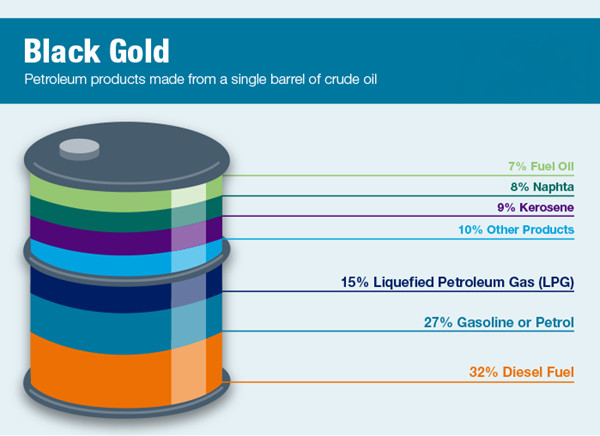Crude oil, often visualized as a thick, black, viscous liquid gushing from oil rigs, is often referred to as “black gold”. This moniker arises from the vast array of products derived from unrefined crude oil. From gasoline and diesel powering our vehicles to heating oil warming our homes, and countless petroleum-based products like naphtha, waxes, and lubricating oils that permeate almost every facet of modern life. But Where Does Oil Come From? Let’s delve into the earth’s depths to uncover the origins of this crucial resource and explore other fascinating facts about crude oil.
_1.jpg)
Crude Oil: The Fast Facts
Crude oil is a naturally occurring fossil fuel, meaning it originates from the remains of ancient organisms. Composed primarily of hydrocarbons – hydrogen and carbon atoms – it exists in liquid form within underground reservoirs, nestled in the minute spaces of sedimentary rocks. It can also be found closer to the surface in oil sands. Frequently found alongside natural gas and saline water, crude oil is often used interchangeably with the term “petroleum,” which encompasses both unrefined crude oil and its refined products. Crucially, it’s a non-renewable resource; once depleted, it cannot be easily replenished, highlighting the importance of understanding where does oil come from and managing its use.
Petroleum Products from a Single Barrel of Crude Oil:
 Infographic showing various petroleum products derived from one barrel of crude oil, emphasizing the diverse applications of oil.
Infographic showing various petroleum products derived from one barrel of crude oil, emphasizing the diverse applications of oil.
Unraveling the Mystery: Where Does Crude Oil Come From?
So, where does oil come from exactly? Crude oil is formed from the remains of microscopic marine organisms called diatoms, including algae and zooplankton, that thrived millions of years ago in ancient marine environments. These organisms were the dominant life forms on Earth during that period.
It’s important to note: Dinosaurs lived much later. Therefore, the common misconception that fossil fuels are derived from dinosaurs is incorrect.
During their lifespan, these organisms harnessed solar energy and stored it as carbon molecules within their bodies. Upon death, their remains sank to the ocean floor or riverbeds, becoming buried under layers of sediment, mud, and rock.
Over vast geological timescales, these organic remains were buried deeper and deeper under increasing layers of sediment and organic material. The immense pressure, elevated temperatures, and absence of oxygen transformed the organic matter into a waxy substance known as kerogen. With further heat, pressure, and time, kerogen undergoes a process called catagenesis, converting it into hydrocarbons.
The specific combination of pressure, heat, and the original organic material’s composition dictates the type of hydrocarbon formed. In this scenario, crude oil is the result. Other hydrocarbons that can form include asphalt at lower temperatures and natural gas at higher temperatures. Once formed, oil migrates through tiny pores in the surrounding rock from areas of high pressure to low pressure, often moving upwards. Some oil may reach the surface and pool, while in other cases, it becomes trapped beneath impermeable layers of rock or clay, forming underground reservoirs – the sought-after sources of crude oil.
The Depths of Oil Reservoirs: How Deep is Crude Oil Underground?
While it may seem that oil sources are constantly being found at greater depths, the reality is more nuanced. Oil itself has primarily moved upwards over geological time. The increasing depth of oil wells reflects the depletion of shallower, more easily accessible reservoirs, necessitating drilling deeper and further to reach remaining oil deposits. In 1949, the average depth of oil wells was approximately 3,500 feet.
By 2008, this average depth had increased to 6,000 feet. The deepest well currently extends to an astonishing 40,000 feet, exceeding the height of Mount Everest by over 11,000 feet. It’s important to remember that “depth” refers to the drilling distance, which can include significant horizontal stretches, not just vertical descent.
The Hunt for Black Gold: How Do We Find Oil?
Geologists are the experts in locating oil, a process known as oil exploration. They seek areas with the geological characteristics indicative of an “oil trap,” the geological formations where oil accumulates. Oil deposits are often found in vast underground reservoirs located in areas that were once ancient seas, either beneath land or the ocean floor.
In the early days of oil exploration, geologists relied on studying soil, surface rock, and other surface features to identify potential subsurface oil deposits. Advancements brought satellite imagery and sophisticated technologies like gravity meters, magnetic field sensors, and “sniffers” capable of detecting hydrocarbon odors.
Today, the most prevalent method involves generating shock waves that travel through rock layers and reflect back to the surface. These reflections are analyzed to identify potential oil traps. Seismic source devices, such as compressed-air guns, thumper trucks, or even explosives, are used to generate these waves. Once a promising location is identified, GPS coordinates on land or marker buoys at sea are used to pinpoint the drilling site.
Global Oil Production: Which Countries Lead?
According to the International Energy Agency (IEA), global oil production averaged 100 million barrels per day in 2018. This figure includes 32 million barrels per day of crude oil and 68 million barrels of crude oil, condensates, natural gas liquids (NGLs), and oil from unconventional sources.
The top five oil-producing nations account for over half of the world’s crude oil production. As of 2019, the leading oil-producing countries were:
- USA – 17 million barrels per day
- Russia – 12 million barrels per day
- Saudi Arabia – 10 million barrels per day
- Canada – 6 million barrels per day
- Iraq – 5 million barrels per day
The Future of Oil: How Much Oil is Left in the World?
With oil production continuing its decades-long rise, experts are grappling with the question of when, or if, oil reserves will be exhausted. Accurately estimating remaining reserves is complex due to the unknown quantities of oil in unexplored regions.
BP has provided an estimate based on “proved reserves,” which represent the amount of oil countries believe they can extract profitably using existing technology at current extraction rates. Their projection suggests that, under current conditions, oil production could cease by 2067 – a mere few decades away.
This projection implies that without discovering new reservoirs, reducing consumption, or developing revolutionary extraction technologies, oil production could potentially end in 2067. However, it’s important to view this date with caution, as past “peak oil” predictions have consistently been revised.
Life After Oil: What Happens If We Run Out of Oil?
As Charles Darwin observed, adaptation is crucial for survival. While humanity can undoubtedly survive without oil, the depletion of oil reserves could trigger profound changes in modern society as we know it. Our dependence on oil extends far beyond transportation and energy.
Oil is integral to nearly every aspect of our lives, from the transportation and production of food, clothing, materials, and pharmaceuticals to the plastics used in countless products. The magnitude of societal change will depend largely on the rate of oil decline and the development and adoption of viable oil alternatives.
The rate of decline is difficult to predict. Enhanced oil recovery techniques and the economic viability of previously inaccessible locations could extend oil production for many years. However, rising oil prices, driven by increasingly complex and expensive extraction processes coupled with growing global demand, are likely. This price increase may incentivize consumers to seek more cost-effective alternatives and drive innovation in production and refining efficiency.
The future of oil suggests it will remain a critical resource for the foreseeable future. While a sudden, catastrophic oil shortage is unlikely, a gradual transition driven by economic factors and the imperative to develop alternative energy sources is more probable. Investing in research and development of alternative resources and enhancing the efficiency of our current resource utilization are crucial steps for a sustainable future.
Howden equipment plays a vital role in various oil and gas processes, including refining, petrochemical production, and transportation. We are committed to developing innovative products and systems that meet and exceed environmental standards while delivering optimal results.

